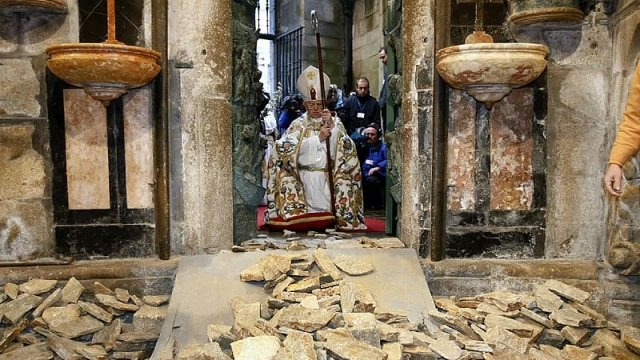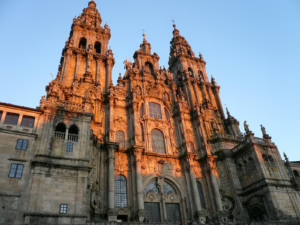The Xacobeo Year is an event that transcends mere religious celebration; it is a convergence of culture, history, and traditions that draws thousands of pilgrims and tourists each year. Understanding its meaning and the importance of its observance will allow you to better appreciate this rich experience. Below, we will explore in depth this unique phenomenon.
What is the Xacobeo Year?
The Xacobeo Year, also known as the Jacobean Holy Year, is celebrated in Santiago de Compostela, Spain, and occurs whenever July 25 — the feast of Saint James the Apostle — falls on a Sunday. This event holds great significance both for believers and for lovers of culture and history.
The tradition is deeply rooted in Christianity, as Saint James is considered the patron saint of Spain and one of the most important apostles of Jesus Christ. The Camino de Santiago, which leads to his tomb in Santiago de Compostela, has become one of the world’s leading pilgrimage destinations.
The Xacobeo Year is celebrated in a special way, with a series of religious, cultural, and artistic activities throughout the year, drawing millions of visitors from various parts of the world.
History of the Xacobeo Year
The history of the Xacobeo Year dates back to the Middle Ages, when the pilgrimage to Santiago de Compostela began to gain popularity. This journey became one of Christianity’s three great pilgrimage routes, alongside Rome and Jerusalem.
In 1122, Pope Callixtus II granted plenary pardon to those who visited the tomb of Saint James, which further encouraged pilgrims to undertake the journey. Over the centuries, this tradition has been maintained and adapted, becoming a symbol of faith and European unity.
Today, the Xacobeo Year isn’t just a religious event—it’s also a time to celebrate Galician culture, with a series of festivities encompassing music, dance, gastronomy, and art.
When is the Xacobeo Year celebrated?
The next Xacobeo Year will be in 2027, because it’s required that July 25 falls on a Sunday. However, in years when that doesn’t happen, the festivities extend to the celebrations preceding and following this special date. Additionally, there are related events and activities held throughout the year to keep the tradition alive.
The planning of the festivities begins years in advance, allowing an extensive range of activities to be organized, including:
- Special masses in the Cathedral of Santiago.
- Concerts and festivals of traditional music.
- Art and Galician culture exhibitions.
- Gastronomic events highlighting local cuisine.
- Hiking routes and other outdoor activities.
Spiritual significance of the Xacobeo Year
For many, the Xacobeo Year represents an opportunity for spiritual renewal. Pilgrims who walk toward Santiago do so in hopes of finding inner peace, redemption, or answers to their deepest questions. The experience of walking the Camino de Santiago is, in itself, a transformative journey.
Over the centuries, diverse groups have found meaning in this pilgrimage, including:
- Christian pilgrims seeking faith and devotion.
- Tourists wanting to experience culture and history.
- People in search of a space for personal reflection.
The Cathedral of Santiago, with its impressive architecture and rich history, acts as a spiritual beacon, welcoming all who arrive with open hearts.
Activities and celebrations during the Xacobeo Year
During the Xacobeo Year, Santiago de Compostela transforms into a festive hub. The city offers a wide variety of events and celebrations that attract both locals and tourists. Some of the standout activities include:
- Concerts in the Plaza del Obradoiro, featuring local and international artists.
- Craft fairs showcasing Galician artisan products.
- Theatrical performances and folk dances showcasing Galician culture.
- Guided Camino de Santiago routes allowing visitors to experience the historic route.
- Galician gastronomy, with food events celebrating local cuisine and fresh ingredients.
The Camino de Santiago: a unique experience
The Camino de Santiago is more than a simple route; it is a transformative experience that has drawn millions over the years. Although there are various routes leading to Santiago, they all share the same goal: to bring pilgrims to the Cathedral where the remains of Saint James the Apostle rest.
Some of the most popular routes include:
- French Way (Camino Francés): The most well-known route, starting from St. Jean Pied de Port, France.
- Portuguese Way (Camino Portugués): Popular among Portuguese pilgrims, starting from Lisbon or Porto.
- Northern Way (Camino del Norte): Along Spain’s northern coast, offering spectacular views.
- Primitive Way (Camino Primitivo): The oldest route, taking pilgrims through the mountainous landscapes of Asturias.
- Vía de la Plata: A route that crosses western Spain, beginning in Seville.
Cultural and tourism impact of the Xacobeo Year
The Xacobeo Year has a significant impact on Galician culture and tourism in Spain more broadly. The large influx of pilgrims and tourists during this period revitalizes the local economy and promotes Galician culture on the international stage.
Tourism related to the Xacobeo Year has led to growth in several areas, including:
- Increased demand for accommodation and tourism services.
- Promotion of Galician gastronomy in restaurants and fairs.
- Development of cultural and recreational activities highlighting local history and traditions.
- Initiatives to preserve and restore the region’s cultural heritage.
The Xacobeo Year is an event that goes beyond religion; it is a celebration of life, culture, and history that unites people from all corners of the world. With each celebration, the tradition of pilgrimage is reinforced and Santiago de Compostela’s rich heritage continues to live vibrantly for future generations.

